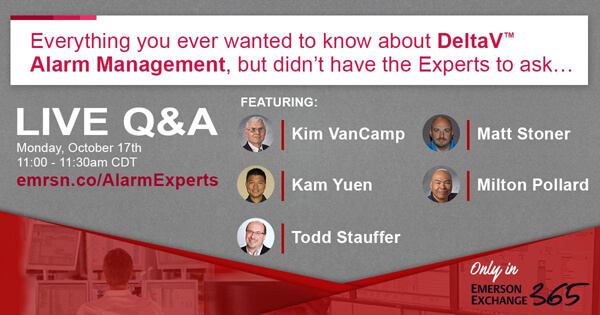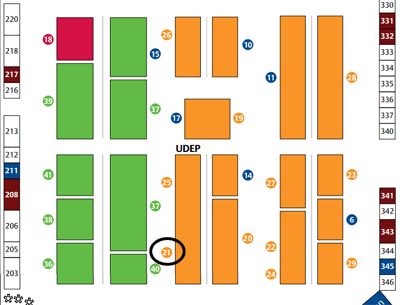The power of on-line technical communities is the knowledge exchange among experts. Instead of this knowledge being buried in email archives, it’s available for others to search and find—even well after the fact.
Today we hosted a live Q&A session on alarm management for DeltaV systems in the Emerson Exchange 365 global user community. The alarm experts featured Emerson’s Kim VanCamp, Kam Yuen, Matt Stoner, Milton Pollard and exida’s Todd Stauffer.
Don’t worry that you may have missed the session since all questions and answers are available in this thread, Everything you ever wanted to know about Alarm Management, but didnt have the Experts to ask…
Here is a sample of some of the questions asked and answered.
Q: How can you separate alarms from alerts per ISA18.2 in the DeltaV system?
A: Kim—In the DeltaV system there are twelve user assignable priority levels, 4-15, where 15 is highest. Use one or a few of the lower levels for alerts and use workstation settings to set the alarm banner priority threshold to exclude these alerts from the alarm banner. This also prevents the alerts from sounding the horn and appearing in the alarm list which is by default set to apply the alarm banner thresholds. Custom alert lists can be created to specify the alert priority levels.
If the system is a V13.3 system, additional filters can be applied to create specialized alert lists based on alarm category and functional classification. So you can easily create alert lists for specific abnormal conditions such as active interlocks.
Q: Alarms suppressed in a flood suppression module appear to come back as “acknowledged” when the flood module logic is reset, or the conditions aren’t “true” anymore. Is this by design? It seems to me that when I manually removed suppression / shelving, if the point is in alarm is behaves as if it is unacknowledged and makes the alarm sound. Is there any reason one shouldn’t use the DeltaV “flood” suppression modules for state-based suppression? We’re in the midst of a month long turnaround and the operators would appreciate it if certain alarms stopped chattering…
A: Kim—Yes, by product design an alarm that exits suppression is in an acknowledged state. Interested in your thoughts on this. Matt—…no that could be used and probably work well to do the state based suppression but we have been working on a State-based suppression module. Are you going to Emerson Exchange next week? I could give you a quick demo and would like to get your thoughts.
Q: Isn’t the use of suppression in a flood condition intended to be a “tacit” acknowledgement of multiple alarms? If the individual alarm triggers outside of the condition that caused the initial flood, when suppression is removed then I would assume it acts as a new alarm.
A: Matt— If the alarm wasn’t active when the flood occurs but the alarm gets suppressed, becomes active while it is suppressed, it will still come back as Active and Acknowledged when suppression is removed. This is how the product works with suppression.
Q: Does the latest Analyze 4.0 backward compatible with all the previous versions of DeltaV?
A: Kam— DeltaV Analyze 4.0 is compatible with DeltaV 13.3.1 and 12.3.1. If you are using DeltaV 11.3.1, you will need to use Analyze 3.0. To get Analyze 3.0, you can buy Analyze 4.0 and download the 3.0 installation media from Guardian.
Q: I would like to know what best practices are recommended with regards to “Off Delays” time as a default.
A: Milton— Refer to ISA18.2 technical report #3 Basic Alarm Design. The report suggests assigning default on/off times based on type of process variable, level, temperature, etc.
Q: What are the main differences between the 2016 version of the ISA-18.2 standard and the 2009 version?
A: Todd— The two versions are largely the same, however, there are some key differences that end users, integrators and suppliers should be aware. Firstly the definition of an alarm now includes the word “timely”, as in “an alarm requires a timely response by the operator”. This change synchronizes the definition with the international version of the standard (IEC 62682).
Additional topics were added for discussion / documentation in an alarm philosophy document. The philosophy is now required to address Alarm System (Management) Audit, Alarm Design Guidance, and Alarm Response Procedures. It is recommended that the philosophy document how you plan to use alarm shelving.
View the thread for more great questions and answers on alarm management. If you’ll be joining us in Austin next week for the Emerson Exchange conference, make sure to catch some of these alarm management based sessions:Speaking of alarm shelving (a form of manual alarm suppression)..The standard now dictates that alarm shelving is “required” functionality. This is good news for DeltaV users because alarm shelving is built-in and provides many options for how it can be applied.
- Seven Steps to a Peaceful Control Room: How to Implement an Effective Alarm Management Program for your DeltaV System
- DeltaV Alarm Management and Logbooks Product Update
- State-based Alarming and Control in DeltaV – A MOD5 Modernization Case Study
You can also find the alarm experts in the alarm management section of the exhibits area.






